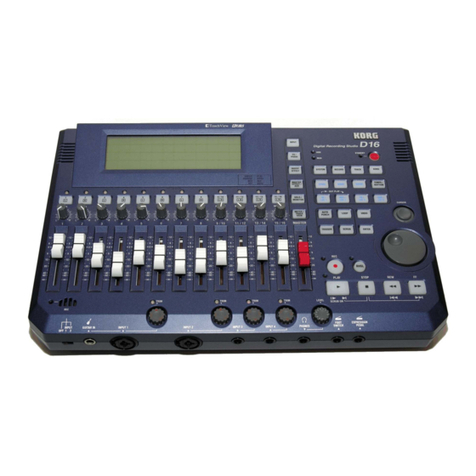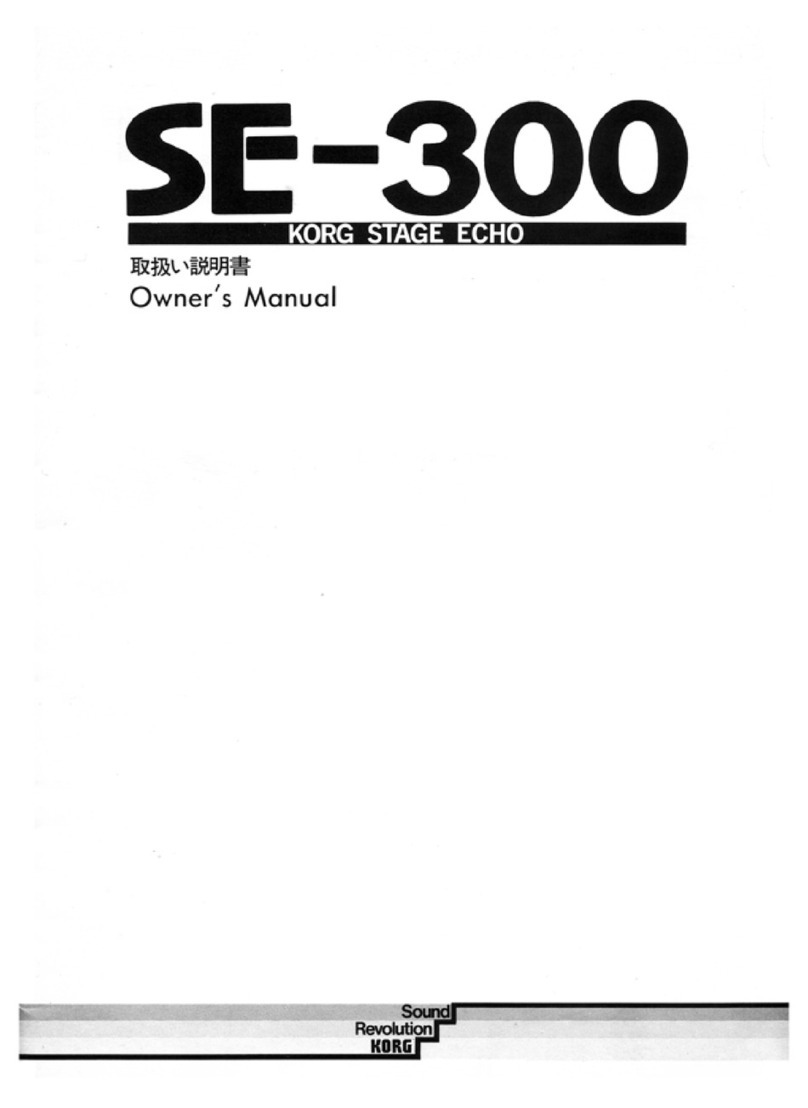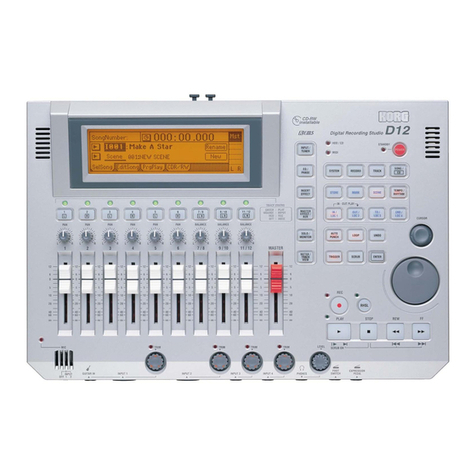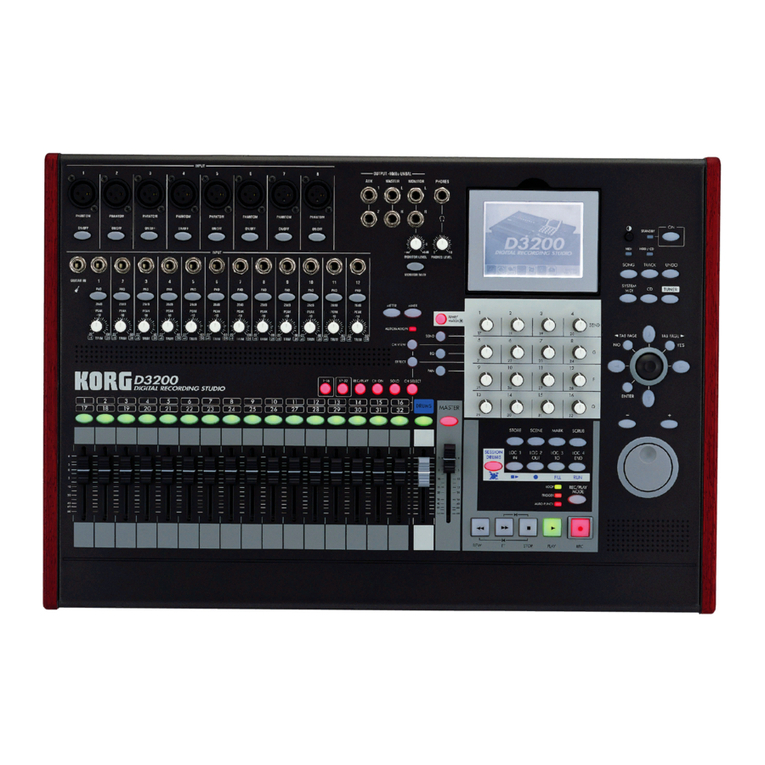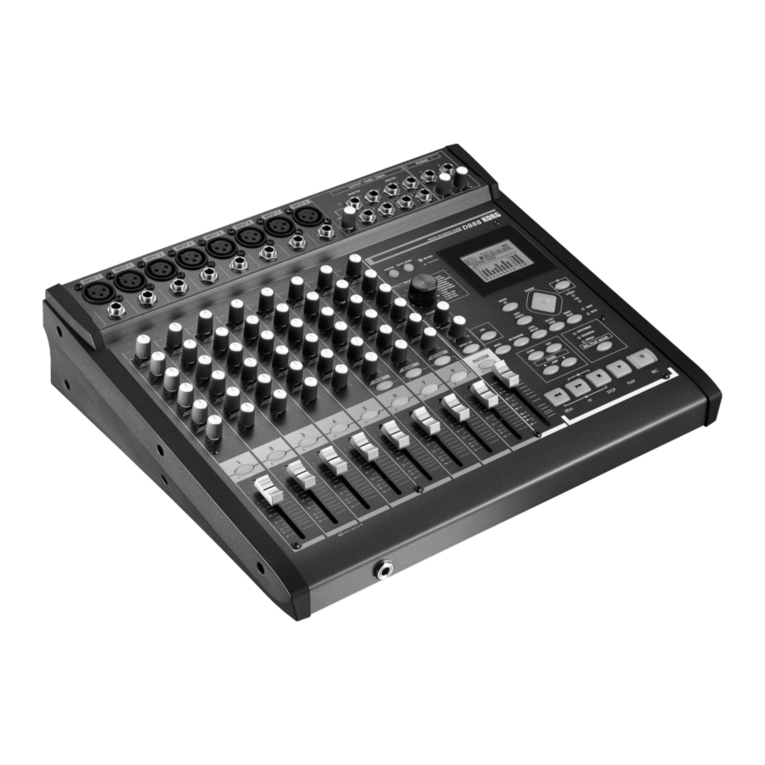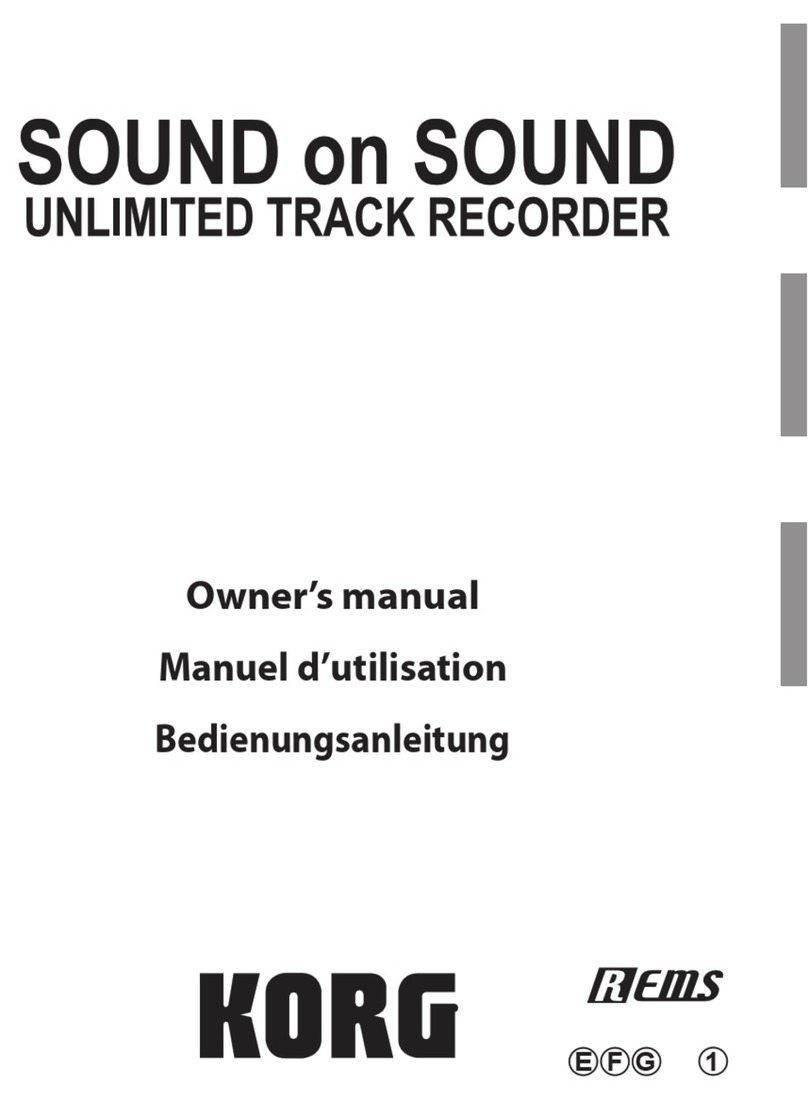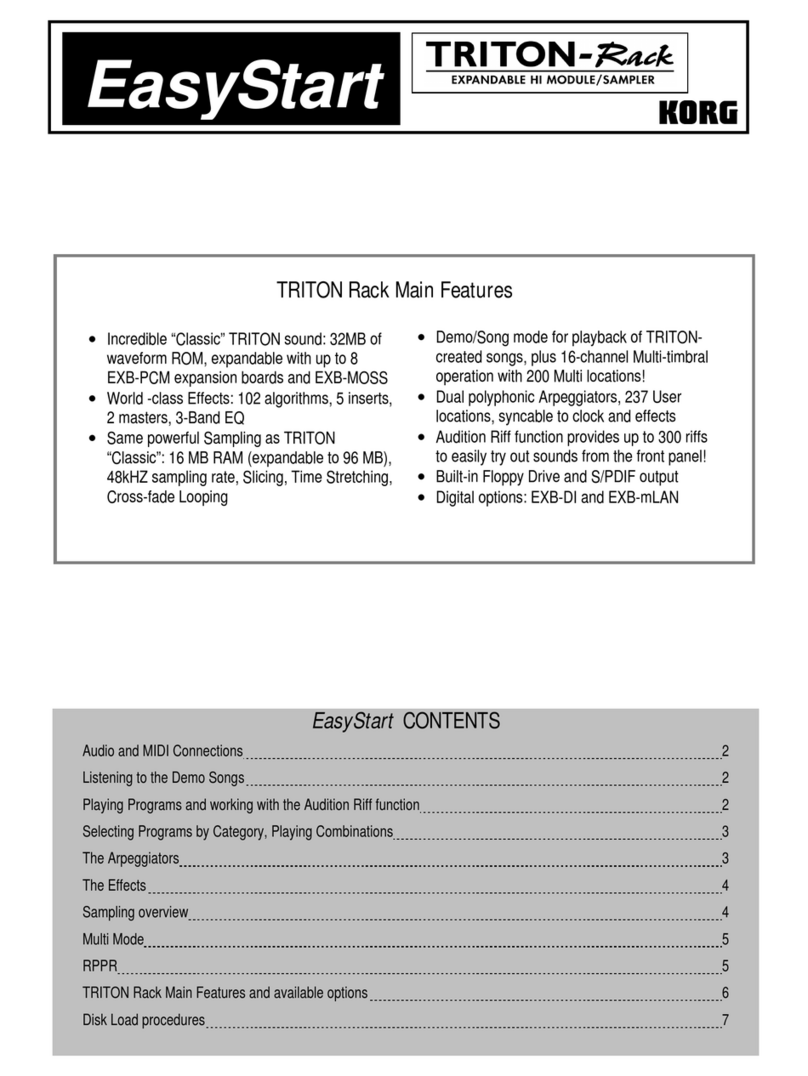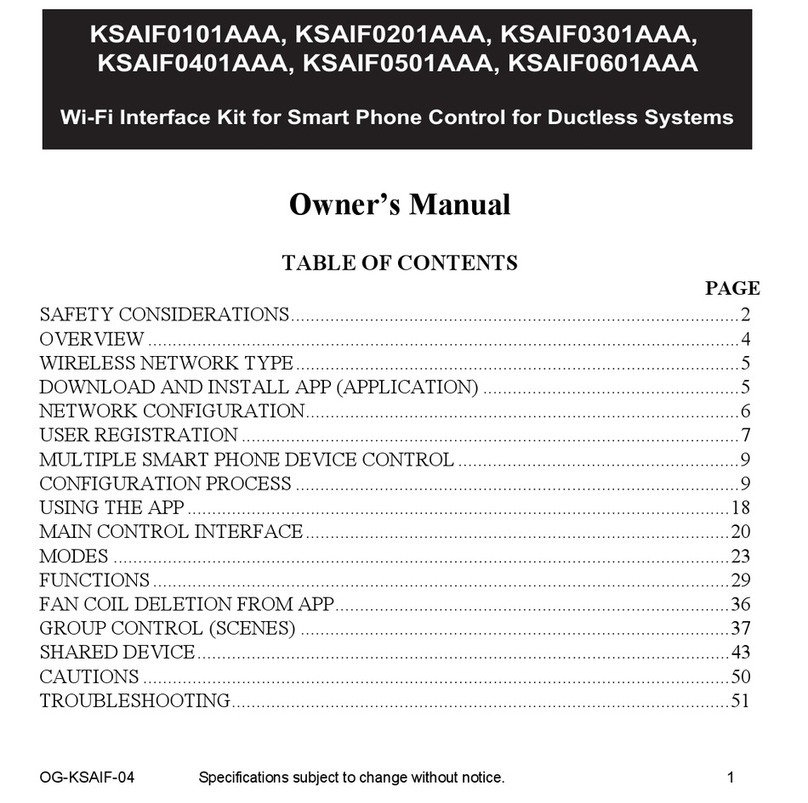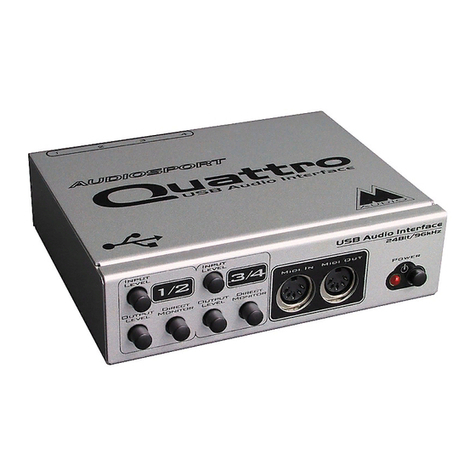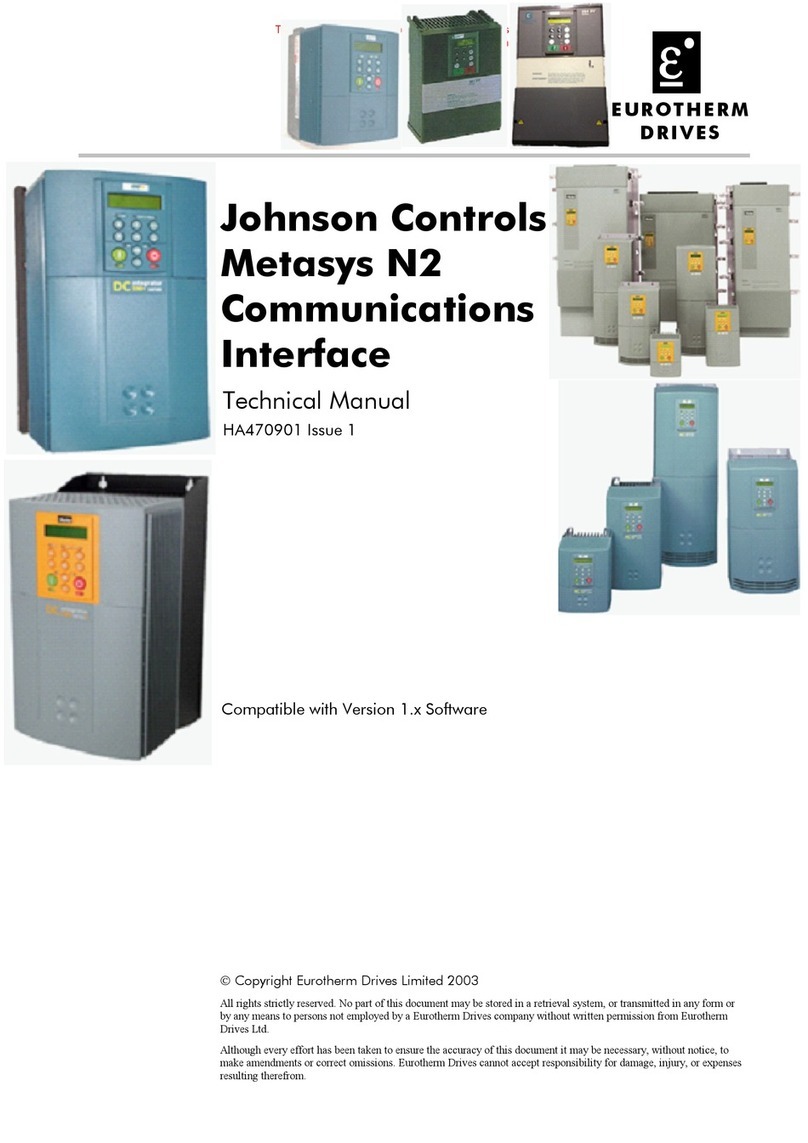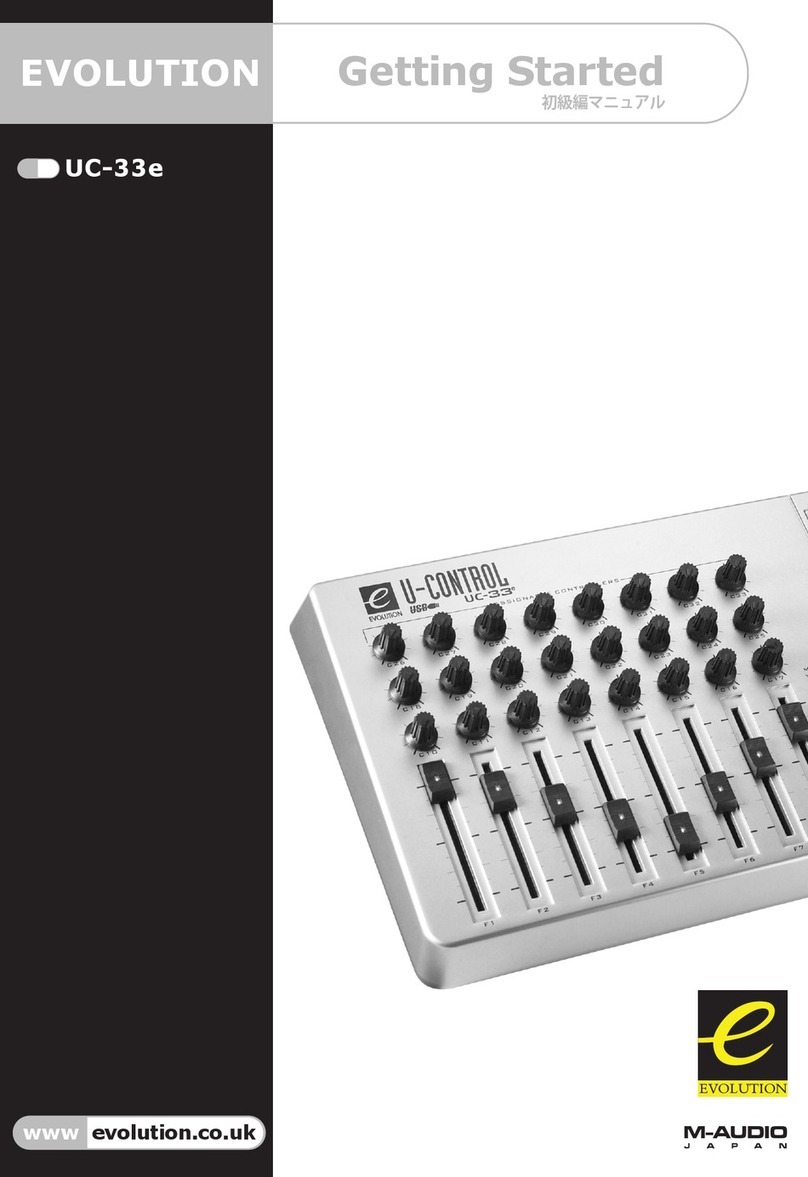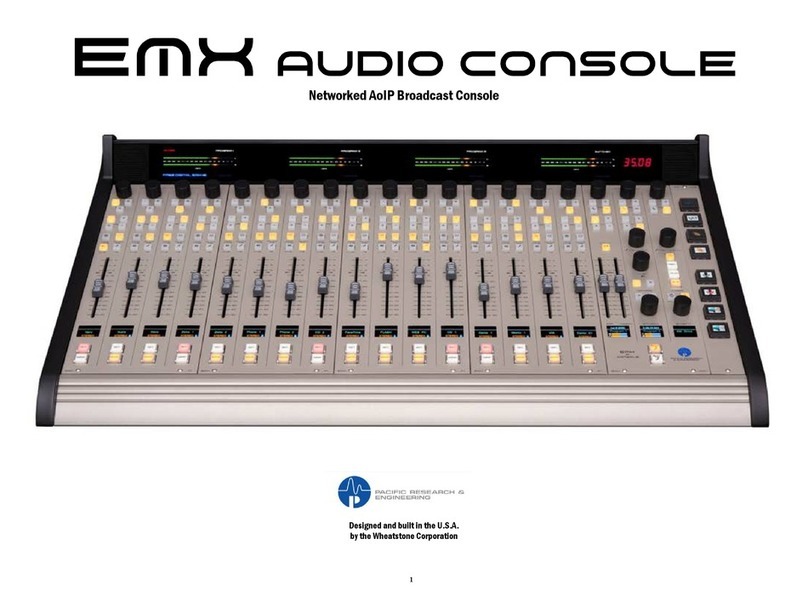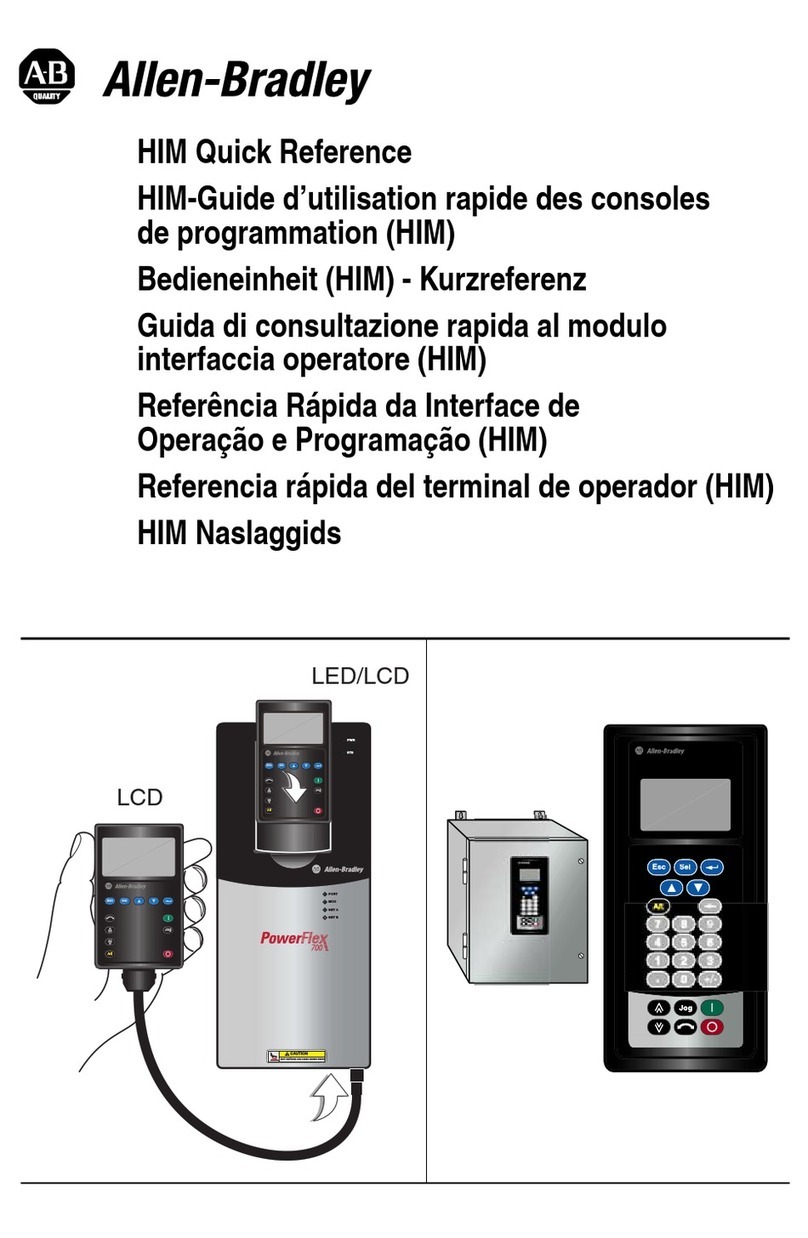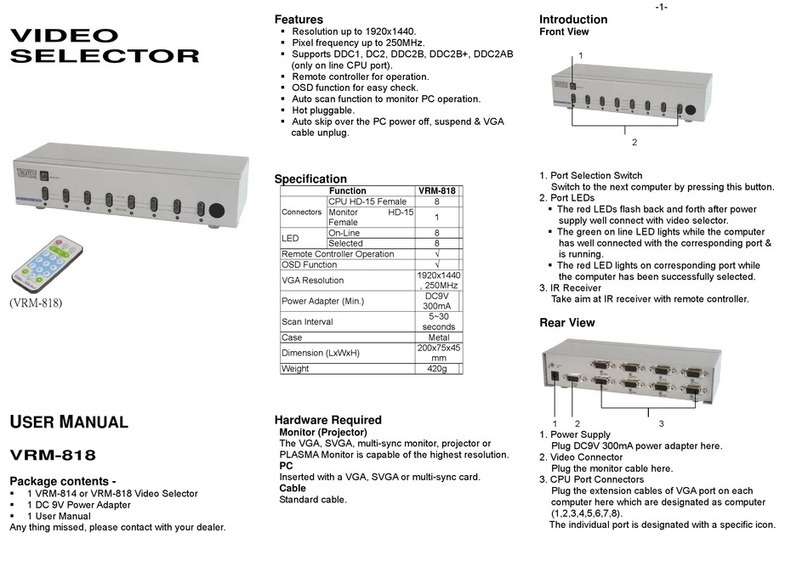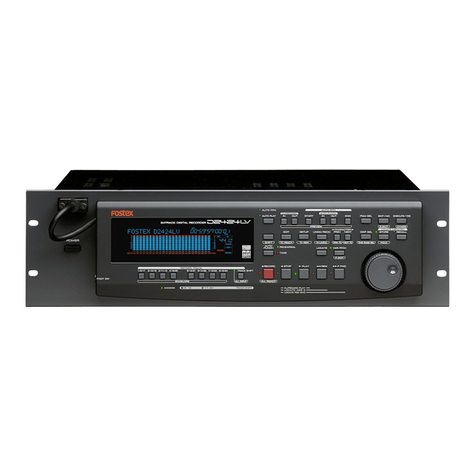Korg EX-800 User manual

■
■
■
1
■
KORG
KORG
PROGRAMMABLE
POLYPHONIC
SYNTHE
MODULES
H
CONTENTS
1.
SPECIFICATIONS
1
2.
MIDI
IMPLEMENTATION
2
3.
STRUCTURAL
DIAGRAM
5
4.
BLOCK
DIAGRAM
7
5.
CIRCUIT
DIAGRAM
.'
8
6.
PC
BOARD
11
7.
CIRCUIT
DESCRIPTIONS
14
8.
TROUBLESHOOTING
TABLE
16
9.
CHECK
AND
ADJUSTMENT
PROCEDURE
17
10.
PARTS
LIST
19
II
KEIO
ELECTRONIC
LABORATORY
CORPORATION
TOKYO/JAPAN
Scan by Manual Manor
http://www.markglinsky.com/ManualManor.html

1.
SPECIFICATIONS
•
Voice
8
Voice
(WHOLE
mode)
4
Voice
(DOUBLE
mode)
•
DCO
1
Octave
(LOW,
MID,
HIGH),
Waveform
(
K.n),
16'
8'
4'
2'
(ON/OFF)
Level
(0
-
31)
•
DCO
2
Octave
(LOW,
MID,
HIGH),
Waveform
(
K,
n).
16'
8'
4'
2'
(ON/OFF)
Level
adjustment,
Interval
(0
-
12
semitones),
Detune
(-20
cent
MAX)
•
DCO
Mode
(WHOLE,
DOUBLE)
•
Noise
Level
(0
-
15)
(White
noise)
•
VCF
Cutoff
Frequency
(0
•
99),
Resonance
(0
-
15),
Keyboard
Track (OFF,
HALF,
FULL),
EG
Intensity
(0
-
15)
EG
Polarity
(\y,
/S),
Trigger
mode
(for
DEG
3
only)
(SINGLE,
MULTI)
•
Chorus
ON/OFF
•
DEG
1
Attack
time,
Decay
time,
Break
Point
(FOR
DCO
1) level,
Slope
time,
Sustain
level,
Release
time
(ALL
0
-
31).
•
DEG
2
Attack
time,
Decay
time,
Break
Point
(FOR
DCO
2)
level,
Slope
time,
Sustain
level,
Release
time
(ALL
0
-
31).
•
DEG
3
(FOR
Attack
time,
Decay
time,
Break
Point
VCF
&
NOISE)
level,
Slope
time,
Sustain
level,
Release
tirne
(ALL
0
-
31).
•
MG
Frequency,
Delay
time,
DCO
intensi
ty,
VCF
intensity
(ALL
0
-
15).
•
MIDI
Receive
Channel
(1
-
16),
Program
Change
(ENABLE/DISABLE),
Se
quencer
Clock
(INT,
EXT),
Bend
(IN
TENSITY)
•
TUNE
+/-50
cents
•
Key
data
receiv-
Ci~Ce/61
keys
(36-96
at
MIDI)
able
range
I
I
I
I
I
Scan by Manual Manor
http://www.markglinsky.com/ManualManor.html

2.
MIDI
IMPLEMENTATION
n
a
1
Transmission
data
Transmittable
data
consist
of
system
exclusive
messages
only.
These
are
used
for
the
computer
dump
function.
System
Exclusive
Messages
NOTE:
1.
Data
error
message
is
sent
if
there
is
a
check
sum
er
ror
during
memory
load.
Error
message:
(F0h,
42h,
21
h.
01
h,
20h,
F7h)
2.
The
request
sent
by
the
computer
must
be:
F0h,
42h,
21
h,
01
h,
10h,
F7h (where
V
means
hexadecimal).
Memory
data
is
then
output
in
the
order:
F0h,
42h,
21
h,
01
h,
memory
data
check
sum,
F7h
—
2
Reception
data
Channel
Messages
NOTE:
1.
CHANNEL
NUMBER:
nnnn
=
0H-FH
(ch1
y-ch16)
2.
NOTE
NUMBER:
kkkkkkk
=
36~96
If
received
data
is
outside
of
this
range,
it
will
be
trans
posed
to
nearest
note
of
the
same
name.
3.
Negative
numbers
are
ignored.
4.
OMNI
ON/OFF
is
always
interpreted
as
being
accom
panied
by
POLY-ON.
Separate
POLY-ON
or
MONO-ON
messages
are
ignored.
5.
ppppppp
=
0~127
(PROGRAM
NUMBER)
However,
if
number
exceeds
63
then
subtract
64
to
find
value
as
interpreted.
Example:
74
=
10
64
=
0
6.
VOLUME
CONTROL:
vvvvvvv
=
7Fm
is
the
loudest
volume.
decreases
as
value
approaches
OOh.
System
Real
Time
Messages
Volume
CAUTION:
ACTIVE
SENSING
If
FEh
(STATUS
11111110)
is
ever
received,
then
another
FEh
or
other
MIDI
data
must
be
received
every
300ms,
otherwise
the voices
will
be
turned
off.
If
FEh
is
never
received
then
operation
will
continue
as
usual.
i
i
-2-
Scan by Manual Manor
http://www.markglinsky.com/ManualManor.html

i
System
Exclusive
Messages
NOTE:
1.
EX-800
begins
RAM
data
dump
about
300msec
after
it
receives
the
final
F7Hin
the
RAM
data
request
above.
2.
£"
(One word
of
RAM
data)n
Least
significant
8
bits
""
are
used
for
check
sum.
3.
Send
data
to
EX-800
MIDI
IN
in
the
order:
F0h,
42h,
21h, 01h,
memory
data
check
sum,
F7h,
In
ternal.
RAM
Data
Chart
NOTE:
1.
SEQ
DATA
is
as
shown
below.
I
I
i
EXAMPLE:
DC
DATA:
B4h,
02h,
B5h,
02h,
01h,
01h,
B7h,
B9h,
34h,
37h,
BCh,
02h,
02h,
02h,
02h,
02h,
01
h,
01
h,
OOh
2.
CHORD
MEMORY
0
knknkokaknknkn:
KEY
DATA
00000
000:
END
3.
Important:
EX-800
does
not
use
undefined
data
except
for
check
sum.
Panel
Control
I
I
I
-3-
Scan by Manual Manor
http://www.markglinsky.com/ManualManor.html

i
Program
Parameter
per
ONE
note
y////////
'UNDEFINED
////////A
PRAMETER
WITH
^EXCEEDS
BYTE
UNIT.
NO
SPACE
BETWEEN
NOTES
Scan by Manual Manor
http://www.markglinsky.com/ManualManor.html

CO
33
|
33
Scan by Manual Manor
http://www.markglinsky.com/ManualManor.html

TCS-5350-01-1011
220ft
$
DTC114Nx2
0.0022
CD
KLM-596
Scan by Manual Manor
http://www.markglinsky.com/ManualManor.html

CD
5
O
O
SWITCH
MATRIX
O
TO
TAPE
FROM
TAPE
TAPE
INTERFACE
LINE
OUT
L
OUT
O
R/MIX
OUT
PHONE
OUT
Scan by Manual Manor
http://www.markglinsky.com/ManualManor.html

CJ1
CD
00
f
6-2A
C18
Atype;2SA1175
C
type
;
2SC2785
1S2473or
1S1555
NE570or
NE571
_
,
6-5A
6CH0RUS
SW
002
,
LFJMC
To
i€r-l3A
6-13
8.
31
KLM-596<
»
•
,
r
7
i6-12A
6-12B
m
PHONE OUT L
6-ITA
7-2B,
7-2C.
7-lC
6-1OB
V^6oh
J?m6-119
Till
sep
production
From
oct
production
L
J
Scan by Manual Manor
http://www.markglinsky.com/ManualManor.html

O)
7-6B#
7-6C
#
7-3B
to
3-1A#-
2-4C
7-7B#
7-7C
7-4C
•
7-4B
<CW
VR1
10KB
K12261001
7-2C
7-2B0—•
'
CW
7-5C
#7-5B
VR2
TUNE
10KB
3-2A0
k3-3C
KLM-596
EWH-14Ax2
VR3
SPEED
100KC
SW
3-4A*-
COLUMN
To
3-5A#-
KLM-596
3-5C
3-6C
3-7AS
k3-7C
7-1C
#7-1B
3-8C
POWER
SW
o
4
-1A
SW1
1
,D5
,04
■03
,010
,09
,D8
,D7
SW
LINE
1-9C
—•
•
3-9A
,015
,D14
cr^
D11
SW2
2
SW5
3
SW4
4
SW5
5
SW6
6
SW7
7
SW8
8
3-10C
#—03-1OA
.D2
SW9
HOLD
SW10
UP
SW11
DOWN
SW12
PROG/PARA
SW13
WRITE
3-11C
*
3-11A
SW14
START
/STOP
4-14C
4
-9A
.
4-14A>/
LED
3US
FromKLM-596
LED
CONT
From
KLM-596
SW15
STEP
TM1-0lxl5
Dl
:
1S
Scan by Manual Manor
http://www.markglinsky.com/ManualManor.html

6.
PC
BOARD
KLM-596
O
m
X
CD
o
o
zr
o
CD
—K
o
CD
</>
CD
o
CO
00
ICI
IC23
Rl
6CL,
T"
c
R93
,C73
.
«C6
-
0l74>-^-n*i
"Pa
R96
'
' .
PROGRAM
STEPUP
I
40H74
tJzt:—oqTO
doVO,
»o
-11-
Scan by Manual Manor
http://www.markglinsky.com/ManualManor.html

KLM-598
RI8
1
I
I
I
I
1
J27
I
I
I
I
I
I
I
1
I
I
1
-12-
Scan by Manual Manor
http://www.markglinsky.com/ManualManor.html

aavw
03X03H3
t?/WS
C/V\S
B/WS
9031
SQ31
SIO
8d
VkMS
|Q
sa so
^a
CO
20
HlH
ClQ
310
CD
I
I
EdA
aaaao
Scan by Manual Manor
http://www.markglinsky.com/ManualManor.html

7.
CIRCUIT
DESCRIPTIONS
MAIN
CIRCUIT
DESCRIPTIONS
The
EX-800
is
intended
to
be an
expander
unit
for
connec
tion to
synthesizers,
sequencers,
or
other
equipment
that
has
a
MIDI
output.
It
is
essentially
the
POLY-800
without
a
keybord.
However,
there
are
some
differences
in
the
MIDI
functions,
as
detailed
in
the
MIDI
IMPLEMENTATION
notes.
The
memory
backup
system
rs
also
different.
The
EX-800
employs
an
internal
lithium
battery
to
protect
data
in
its
memory.
The
life
of
this
battery
is
about
five
years
and
it
should
be
replaced
after
that
time
has
elapsed.
For
check
and
adjustment
of
the
EX-800
please
refer
to
the
POLY-800
service
manual.
Below
are
simple
descriptions
of
each
circuit
block.
Refer
to
circuit
diagram
for
number.
1)
Tape
interface
input
circuit:
Consists
of
amplifier
and
comparator.
When
command
is
executed,
data
on
this
line
is
input
to
the
CPU
accumu
lator's
7th
bit.
2)
CPU:
A
CMOS
8-bit
microprocessor
IG24
(80C85)
featuring
low
power
consumption.
Virtually
all
POLY-800
functions
are
handled
by
this
CPU.
3)
Reset
circuit:
IC40
(PST518)
is
a
3-pin
IC
used
for
reset.
It
generates
an
initial
reset
voltage
of
about
4.2V.
4)
Sequencer
tempo
clock
oscillator
circuit
The
tempo
circuit
includes
IC28
(TC40H074)
and
1/2
of
IC36(whichis1/2ofaTL072).
The
tempo
control
is
connected
to
CN2
pin
1
providing
10Hz±20%
at
the
knob's
0
position
and
100Hz±20%
at
the
10
position
for
CPU
interrupts.
If
this
circuit
fails,
then
there
will
be
no
sound
from
the
sequencer
section.
5)
Interrupt
oscillator
circuit:
This
oscillator
cycle
is
used
for
the
EG,
MG,
LED
displays,
and
S/H
time
division
processing.
Oscillator
frequency
is
2400Hz-N-3600Hz.
Interrupt
order
is
by
priority.
If
this
circuit
fails,
EG
operation
and
LED
indication
may
become
erratic.
6)
Address
Decoder:
TTL
circuit
decodes
addresses
for
RAM
and
other
ICs.
i
7)
ROM
(8192
words
x
8bit
PROM)
8)
RAM
(2048
words
x
8bit
static
RAM)
9)
Address
latch:
IC
latches
according
to
CPU
ALE
(Address
Latch
Enable)
terminal
output
signal
since
CPU
uses
address
LSB
8bits
together
with data
bus
8bit
input.
10)
Peripheral
I/O:
PA,
PB,
and
PC
ports
are
all
used
for
output.
The
internal
timer
is
used
for
the
interface
IC26
(63B50)
reference
clock.
The
CPU
3MHz
clock
frequency
is
divided
by
6
to
obtain
500kHz.
RAM
is
used
for
the
program working
area.
11)
LED
display
drive
circuit:
IC30
(BA618)
and
IC31
(M54513)
form
a
6
x
8
matrix
for
time
sharing
indication
by
the
panel's
7-segment
LED
display.
12)
8-bit
D/A
converter:
Uses
CMOS
noninverting
buffer
IC32(HD
14050or
"4050"),
and
BR9
(RKM10L253F
or
"BR9")
a
10-pin
(R=25kohm)
R-2R
ladder
resistor
in
D/A
converter
with
output
of
0V
^
4V.
13)
External
DC
power
supply
ripple
filter:
Diode
D2
is
used
to
protect
the
circuit
in
case
of
reverse
AC
adapter
polarity.
14)
LED
display
power
supply:
Circuit
is
designed
so
that
LEDs
become
dim
when
battery
voltage
drops
below
rated
level,
(about
6V)
15)
+5V
power
supply:
This
circuit
design
is
employed
because
it
maintains
normal
operation
up
until
just
before
the
batteries
drop
below
rated
voltage
of
Volts
(about
6V)
16)
-5V
power
supply:
A
type
of
DC-DC
converter.
18)
A/D
converter
comparator.
19)
Master
oscillator:
Varactor
VC1
and
coil
KL-003
are
used
in
the
oscillator
circuit.
This
generates
a
frequency
of
about
2MHz
at
the
tune
knob's
center
position.
This
is
divided
down
(to
about
1MHz)
to
supply
the
TG.
(CL1,
CL2)
Bend
and
vibrato control
voltages
are
D/A
converted
by
IC35
(3404)
and
applied
to
the
oscillator.
20)
EG
S/H
circuit:
EG
values
calculated
by
the
CPU
are
output
by
time
sharing
and
input
to
the
TG.
LED
diodes
for
each
voice
are
there
to
smooth
the
stepped
transition.
21)
Keyboard
panel
switch
input
circuit:
A
9
x 8
matrix
is
formed
by
DTC5,
IC34
(TC40H138),
and
IC33
(TC40H240).
This
handles
keyboard
and
panel
switch
outputs
as
well
as
output
from
the
comparator
in
circuit
diagram
(18).
I
I
I
I
I
i
i
i
i
i
i
i
i
i
i
i
-14-
i
Scan by Manual Manor
http://www.markglinsky.com/ManualManor.html

22)
Detune
circuit:
Lowers
frequency
by
thinning
out
clock
pulses.
23)
Tape
interface
output
circuit.
24)
CV
circuit:
Performs
time
division
output and
S/H
on
CV
for
VCF
and
master
oscillator.
25)
6-bit
latch
circuit:
A
6-bit
control
output
circuit
with
2
bits
for
detune,
2
bits
for
DCO
waveform
switching,
1
bit
for
A/D
converter,
X-Y
switching,
and
1
bit
for
noise
gate
control.
26)
6-bit
latch
circuit:
A
6-bit
control
output
circuit
with
5
bits
for
S/H
control
and
1
bit
for
chorus
on/off
switching.
27)
VCA
+
VCF
circuit:
The
IC1
(NJM2069)
has
three
internal
VCAs
and
one
internal
24dB/oct
VCF
(LPF).
SIG1
and
SIG2
respectively
receive
mixed
DC01
and
DC02
inputs
from
the
TG;
LEVEL1
and
LEVEL2
are
control
input
terminals.
The
other
VCA
is
for
noise
only.
The
9pin
(VCA
LIN
IN)
is
its
control
terminal.
MG,
EG
INT
and
CUTOFF,
KBD
TRACK
are
controlled
separately
and
input
to
VCF
LOG.
See
REFERENCE
DATA
for
details.
31)
Waveform
synthesis
circuit:
Using
the
TG's
various
foot
outputs
(16',
8',
4',
and
2'),
this
produces
2-waveforms,
one
by
addition
on
a
1
=
1
=
1
=
1
basis
and
the
other
using
the
ratio
1
=
1/2=1/4=1/8.
The
block
resistor
BR5
(RKC
1/8
B4
33K)
is
made
up
of
four
1/8W
33k
resistors
(1
=
1
=
1
=
1).
BR6
(RMO0470)
is
10K
ohms
using
R,
2R,
4R,
8R
(1
=
1/2=1/4=1/8).
32)
TG
(Tone
Generator):
An
IC
having
eight
sets
of
dividers
and
VCAs.
See
REFERENCE
DATA
for
details.
KLM-598,614
KLM-598
consists
of
the
chorus
circuit
and
headphone
amp
circuit.
The
VCF
output
signal
transits
noise
gate
F1
(2SK381)
and
is
input
to
compressor
IC3
(NE570);
then
IC4
(M5224P)
detects
the
envelope.
The
clock
generator
circuit
which
drives
the
BBD
IC
makes
IC7
(M5224P)
generate
a
triangle
wave
which
comparator
IC8
(393)
converts
to
a
sawtooth
wave
with
a
change
of
pitch
for
a
more
natural
chorus
effect.
F2
(2SK381B)
at
the
output
is
an
FET
for
chorus
on/off
switching.
KLM-614
includes
the
panel
section
LED
display
and
switch
matrix
circuitry.
28)
Analog
switch
circuit:
Performs
DCO
waveform
switching
and
joystick
A/D
con
verter
input
switching.
29)
Noise
generator.
30)
MIDI
interface
circuit:
This
is
a
standard
type
MIDI
interface
circuit
employing
the
MIDI
interface
IC26
(ACIA63B50)
and
high
processing
speed
photocoupler
PC-1.
(PC-900)
D22
is
used
to
prevent
destruction
of
the
photocoupler
LED
in
case
a
reverse
voltage
is
applied.
R119
(220
ohm)
and
R121
(220
ohm)
resistors
are
for
prevention
of
damage
in
case
of
excessive
current.
The
circuit
is
designed
to
provide
a
data
transmission
rate
of
31.25
k
baud(±1%).
-15-
Scan by Manual Manor
http://www.markglinsky.com/ManualManor.html

8.
TROUBLESHOOTING
TABLE
The
order
in
which
things
should
be
checked
naturally
coincides
with
the
signal
path
in
the
POLY-800.
Please
refer
to
this
flow
chart
to
help
you
pinpoint
sources
of
malfunctions.
Remember
to
save
user
programs
to
tape
before
beginning
service
procedures.
No
sound
or
other
malfunction.
Try
loading
data
from
accessory
tape.
Check
+5V
(No.
15),
-5V
(No.
16)
supply
voltage
{No.
13,
16)
for
±5V.
Is
tone
generator
(IC3)
output
correct?
Is
waveform
^\
NO
synthesizer
circuit
(No.31)
output
normal?
Is
the
correct
signal
being
input
at
VCF
(IC1)20and21
pins?
Check
connector
CN-61
pin.
Is
VCF
output
present?
Check
^
to^see
whether
EG
controL
^signal
is
being
input
pro-
Check
No.
31
circuit
IC,
block
resistors.
Check
analog
switch
circuit
(No.
28).
Check
IC
1
(NJM2069).
Replace.
Is
EG
S/H
circuit-^YES
No.
20)
getting correct
input?
Replace
IC12
(HD14051).
YES
CheckTGIC3
(MSM5232).
Replace
if
necessary.
Check
master
oscillator
cir
cuit
(No.
19).
Check
KLM-598
compressor/expander
IC(IC3),
BBDIC(IC5),etc.
The
problem
is
probably
in
this
circuit
board.
The
problem
is
in
the
main
board
(KLM-596).
Check
CPU,
I/O,
RAM,
ROM,
etc.
control
lines
and
address
and
data
buses
for
problems.
I
I
I
I
I
I
I
I
I
I
I
1
I
I
1
I
-16-
I
I
Scan by Manual Manor
http://www.markglinsky.com/ManualManor.html

9.
CHECK
AND
ADJUSTMENT
PROCEDURE
ADJUSTMENT
PROCEDURE
Use
the
POLY-800
for
check
and
adjustment
of
the
EX-800.
Connections
are
as
shown
here.
Use
a
5-pin
DIN
cable
less
than
15m
long
for
connection.
Note:
The
EX-800
MIDI
OUT
terminal
is
for
memory
dump
to
a
personal
computer
(via
a
MIDI
interface).
Caution:
This
product
has
been
thoroughly
adjusted
at
the
factory
before
shipment.
Therefore
do
not
adjust
anything
other
than
those
VRs
required
for
servicing.
BEFORE
making
any
calibration
adjustments,
Be
sure
test
data
is
loaded
into
EX-800.
The
following
setting
chart
shows
the
program
data
used
for
service
testing.
After
inputting
the
data,
save
it
on
tape
for
future
time
saving
convenience.
PROGRAM
no.
11
(noise
level):
PROGRAM
no.
12
(master
oscillator):
1.
Power
supply
circuit
(KLM-596,
circuit
no.
15):
Be
sure
that
the
specified
AC
adapter
is
being
used:
9V,
300mA,
1)
+5V
check
and
adjustment:
Use
DVM
(digital
voltmeter)
to
check
KLM-596
connector
CN6
Pin
6
and
confirm
+5V
*(±0.005V).
Adjust
VR1
if
necessary.
2)
-5V
check:
Use
DVM
to
check
KLM-596
connector
CN6
Pin
8
and
confirm
-5V
(within
-4.7V
-
-5.7V)
2.
D/A
converter
check
and
adjustment
(KLM-596,
circuit
No.
12):
1)
Select
program
No.12
2)
Set
joystick
bend
control
of
POLY-800
at
center
posi
tion:
BEND
INT
to
10
3)
Connect
DVM
to
KLM-596
IC10
(TL062)
Pin
7
and
confirm
2.001V
±0.005V.
Adjust
VR4
if
necessary.
Also
confirm:
3.984V
±0.005V
for
an
upward
pitch
bend
and
0.024V
±0.005V
for
a
downward
pitch
bend.
Note:
Adjustment
is
easiest
in
the
joystick
circuit
although
the
idea
is
to
obtain
a
4V
output
from
IC
38
(TL062)
by
adjusting
the
D/A
converter
when
IC
81C55
port
A
output
is
all
high.
3.
Noise
level
check
and
adjustment:
1)
Select
program
no.
11.
2)
Depress
any
single
key
of
POLY-800.
3)
Connect
oscilloscope
to
KLM-596
CN6A
1
pin
and
con
firm
noise
level
of
0.3Vp-p
(±
20%).
4)
Adjust
VR3
if
necessary.
-17-
Scan by Manual Manor
http://www.markglinsky.com/ManualManor.html

4.
Master
oscillator
check
and
adjustment:
Set
tune
knob
to
center
and
bend
intensity
to
maximum.
Connect
AT-12
to
line
out
jack.
1)
Select
program
no.
12.
2)
Depress
C3
key
of
POLY-800.
3)
Confirm
AT-12
indication
of
-1
OCT,
C,
Ocent.
If
nec
essary,
adjust
by
turning
KL-003
coil.
4)
Next,
push
joystick
to
maximum
upward
pitch
bend
position
and
confirm
AT-12
reading
of
—1
OCT,
G,
+35
cents.
Adjust
KLM-601
VR2
if
necessary.
5)
At
maximum
joystick
downward
pitch
bend
AT-12
indi
cation
should
be
-2
OCT,
F,
-35
cents.
Adjust
KLM-601
VR1
if
necessary.
VR3
is
a
semi-fixed
resistor
to
fix
range
of
tune
VR
on
front
panel.
Confirm
+40
~
+70
cents
when
tune
VR
is
at
#
max
position.
Confirm
-40
~
-70
cents
when
tune
VR
is
at
b
max
position.
If
necessary,
Adjust
VR3.
5.
Cutoff
check
and
adjustment:
1)
Select
program
No.
13.
2)
Play
C3
key
of
POLY-800
3)
Connect
oscilloscope
to
CN6A
pin
1
and
observe
wave
form
as
in
figure
1.
4)
Adjust
VR2
to
obtain
maximum
waveform
amplitude.
6.
Resonance
check
and
adjustment:
1)
Select
program
no.
14.
2)
Play
C3
key
of
POLY-800.
3)
Confirm
that
waveform
is
as
shown
in
figure
2.
4)
Adjust
VR5
if
necessary
to
prevent
oscillation
or
to
cor
rect
waveform
deviation
from
figure
2
example.
1.5msec
(±20%)
0.1
V/div,
1msec/div
Fig.
2
Fig.
1
-18-
I
I
1
I
I
I
I
I
I
I
1
1
I
I
■
I
I
I
I
Scan by Manual Manor
http://www.markglinsky.com/ManualManor.html

10.
PARTS
LIST
Scan by Manual Manor
http://www.markglinsky.com/ManualManor.html

Scan by Manual Manor
http://www.markglinsky.com/ManualManor.html
Other manuals for EX-800
3
Table of contents
Other Korg Recording Equipment manuals

Korg
Korg Toneworks AX10A Product information sheet

Korg
Korg EFGS 1 User manual
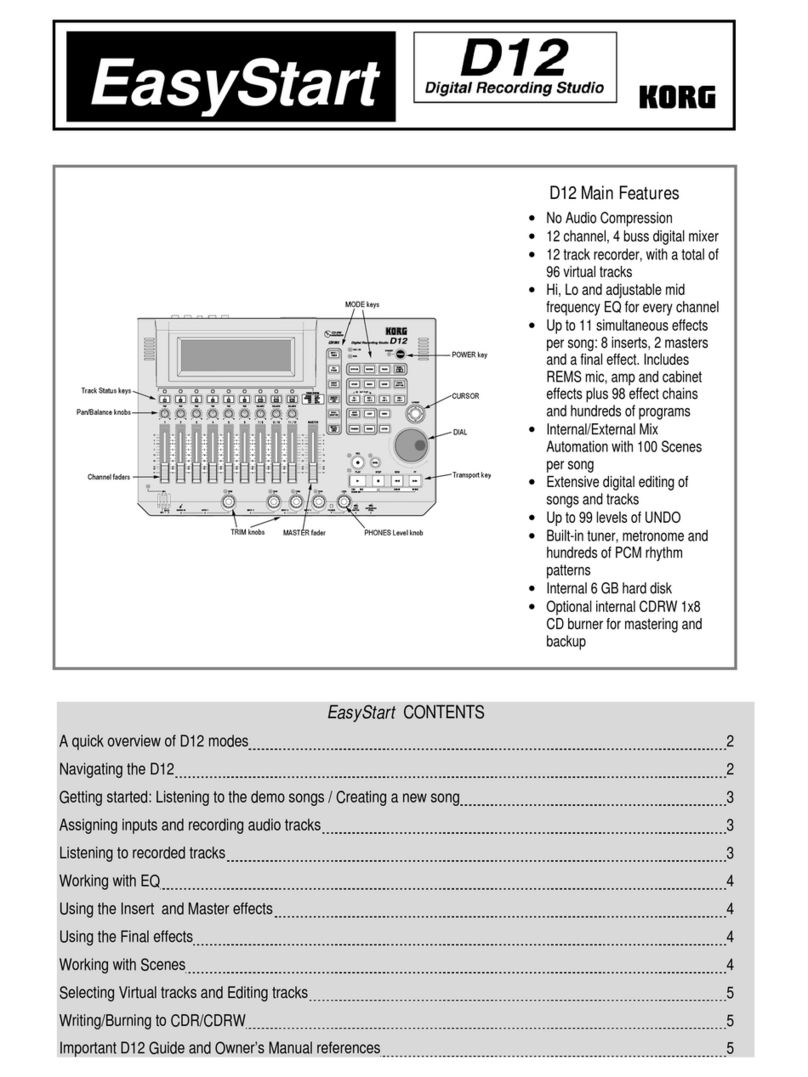
Korg
Korg D12 Instructions for use
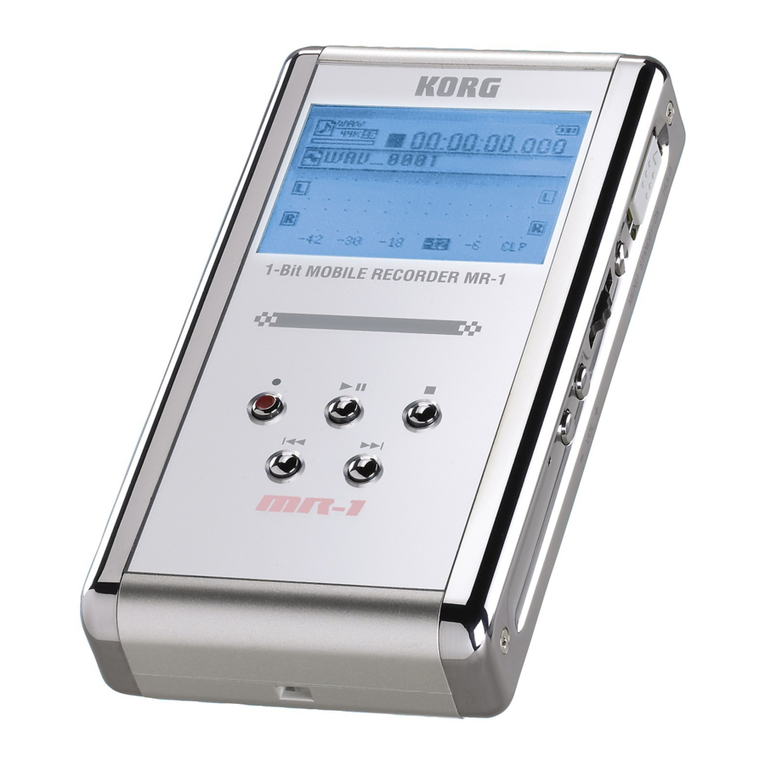
Korg
Korg MR-1 Technical manual
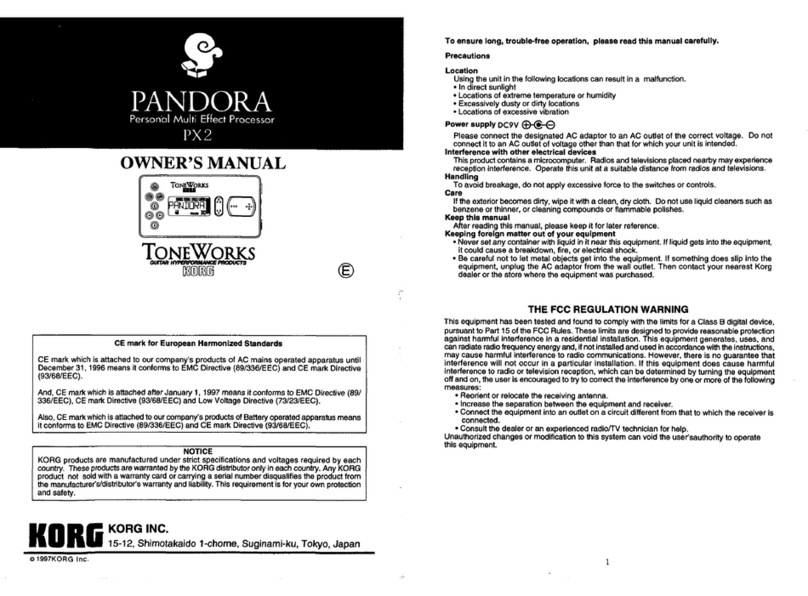
Korg
Korg Pandora PX2 User manual

Korg
Korg PB-CS User manual

Korg
Korg Pandora PX4A User manual

Korg
Korg Electribe ESX-1 User manual
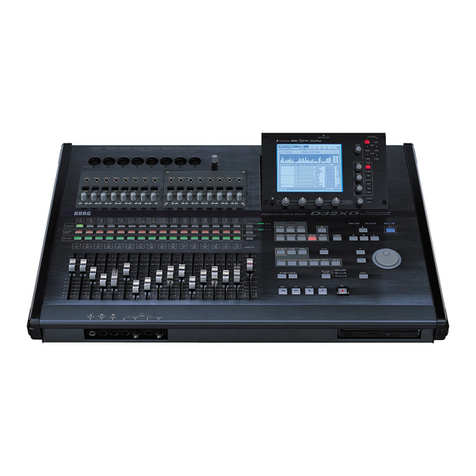
Korg
Korg D32XD Installation and operation manual
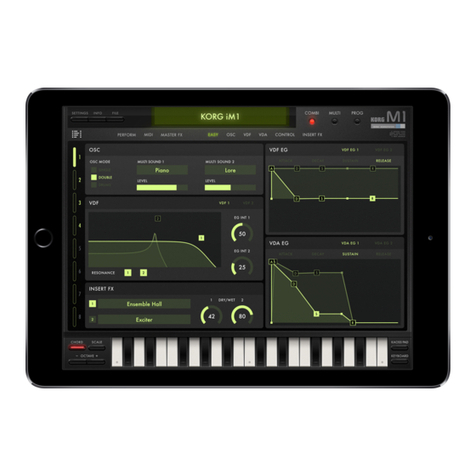
Korg
Korg iM1 User manual
